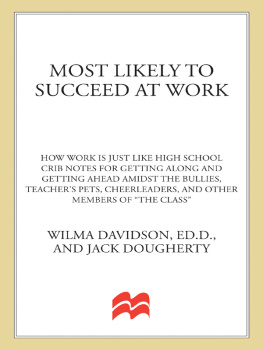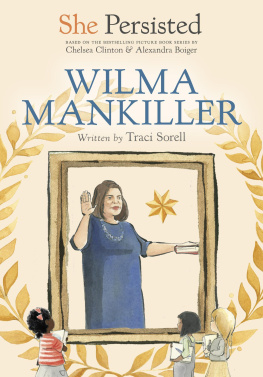Wilma Davidson - Most Likely to Succeed at Work
Here you can read online Wilma Davidson - Most Likely to Succeed at Work full text of the book (entire story) in english for free. Download pdf and epub, get meaning, cover and reviews about this ebook. year: 2003, publisher: St.Martins, genre: Home and family. Description of the work, (preface) as well as reviews are available. Best literature library LitArk.com created for fans of good reading and offers a wide selection of genres:
Romance novel
Science fiction
Adventure
Detective
Science
History
Home and family
Prose
Art
Politics
Computer
Non-fiction
Religion
Business
Children
Humor
Choose a favorite category and find really read worthwhile books. Enjoy immersion in the world of imagination, feel the emotions of the characters or learn something new for yourself, make an fascinating discovery.
- Book:Most Likely to Succeed at Work
- Author:
- Publisher:St.Martins
- Genre:
- Year:2003
- Rating:3 / 5
- Favourites:Add to favourites
- Your mark:
- 60
- 1
- 2
- 3
- 4
- 5
Most Likely to Succeed at Work: summary, description and annotation
We offer to read an annotation, description, summary or preface (depends on what the author of the book "Most Likely to Succeed at Work" wrote himself). If you haven't found the necessary information about the book — write in the comments, we will try to find it.
Most Likely to Succeed at Work — read online for free the complete book (whole text) full work
Below is the text of the book, divided by pages. System saving the place of the last page read, allows you to conveniently read the book "Most Likely to Succeed at Work" online for free, without having to search again every time where you left off. Put a bookmark, and you can go to the page where you finished reading at any time.
Font size:
Interval:
Bookmark:


For my high school sweetheart
For my mother
If youre like most people, you want to go to work, do your job, have some fun, be well paid, be recognized for being good at it, and go home smiling at the end of the day. On the best days, you get all these things, and the experience of work is richly rewarding.
But on the worst days, you go home disappointed, disillusioned, furious, insulted, scared, scarred, and paranoid. Over dinner with your spouse or drinks with your friends, you moan about the office brown-noser who so shamelessly tried to look smart in front of the boss at the staff meeting. Or you gossip about the hot-and-heavy couple in Accounting who are married (though not to each other). Or you complain that you have tried 150 different ways to get the bosss attention, but it is as though you dont exist.
Every day exasperated workers wonder how they will survive the politics and personalities of the modern workplace. Its very exhausting, very stressful, and very real.
Fortunately, survival is a lot easier than you might think. In fact, you may be surprised to learn that you have already navigated an equally stressful and complex organizational structure: high school.
As you strive to increase your success in the workplace (to get along, noticed, and promoted), look back to your high school days for insight, clues, and answers about what worked, what didnt, and why. The deeper you dig into your high school past, the more youll discover that work is simply high school for grown-ups.
The Premise of the Book
High school is never over.
The workplacewhether a high-rise office building, factory floor, or retail storeis really just an adult version of high school, though many of us pretend otherwise. Look around. The Class President is in the corner office. The Party Animal is out entertaining clients. The Class Clown is in the cafeteria doing a wicked imitation of the Class President. The Gossip is busy telling everyone within earshot the skinny on the controllers divorce proceedings. And the Player just accepted the regional vice presidents invitation for drinks after work.
Whether we work on the assembly line or in the executive suite, adults in the workplace gossip, admire, mock, backstab, envy, flatter, covet, cajole, charm, pass notes during meetings, and otherwise behave just as we did in high school. High school is simply a lab for the rest of our life. (Talk about a permanent record!)
Bottom Line
We are who we were in high school, whether we realize it or not. During those years, a mini-adult version of us emerged. Many of the core traits on display then inform our personality and behavior at work today: our ability to make friends easily, or our love of clothes, or our competitive streak, or our willingness to pitch in, or possibly our persistent anger at not being taken seriously. We developed a communication style thena way of presenting ourselves to the worldand that style is either working for us today or it isnt.
The Promise of this Book: How it can Help you
You were typecast in high school and probably are now at work. But whether youre the A Student, Underachiever, Geek, Activist, Complainer, or some combination of our two-dozen archetypes, its not too late to reinvent or reinvigorate yourself. Our goal is to help you downplay the traits that hurt you, pump up the skills that help you, and round yourself out by adopting the best traits from your classer, workmates. Think of our book as the best friend wholl tell you honestly how youre coming across to others.
Heres how to use it.
Find yourself in the archetypes
The archetypes are sorted into two groups: those at the top of the class and those in the bottom.
The top of the class includes folks like the Thespian, Teachers Pet, Jock, Cheerleader, Underachiever, and Party Animal. These likable folks come in all shapes, sizes, colors, and genders. Their values, looks, priorities, pleasures, and peccadilloes may be different, but one thing they all have in common is their fundamental decency. Most readers will find themselves in this section.
The troublemakers in the bottom of the class are a different story. The Gossip, Snob, Know-it-all, Cheater, Prima Donna, and other disagreeable types also come in all shapes, sizes, colors, and genders. The one thing they all have in common is their impactwhich is, sadly, negative. Most readers will recognize someone theyve worked with in this section. (None of us would ever behave this way!) Since the folks in the bottom of the class dont get exposed or punished nearly enough at work, as a service to our readers we made sure they did in our book.
Identify your types core communication strengths
Each archetypes description includes a list of the types core communication strengths. Our aim is to help you leverage your best traits for maximum success and influence in the workplace.
Identify your types core communication weaknesses
Each archetypes description includes a list of the types core weaknesses. Our aim here is to help you prevent them from sabotaging your credibility and undermining your success.
Blend
We said you were typecast in high school and probably are at work, too. If you want to reinvent or reinvigorate your type, the solution is to blend. We encourage you to study all the types in the book and think about the traits you admire. When the charismatic Party Animal decides its time to strengthen his credentials, he might look to the A Student or the Class President for guidance. The Rebel was recently promoted but knows she needs to be more of a team player, so she studies the Cheerleader, Party Animal, Jock, and others in the top of the class.
To illustrate blends, weve included examples.
- Premium Blends are best-case scenarios, achieved when positive archetypes from the top of the class are combined. These are examples only and are not meant to be prescriptive.
- Poisonous Blends are worst-case scenarios, achieved when negative archetypes from the bottom of the class are combined with other classmates. As there are no desirable blends that include a member of the bottom of the class, these are definitely not meant to be prescriptive.
You dont get a second chance at high school; but theres still plenty of time to improve your image and reputation at work, to make the most of your natural style, and to boost your chances for professional success. As the writer George Eliot said, Its never too late to be what you might have been.
So, lets get started, class.
True terror is to wake up one morning and discover that your high school class is running the country.
KURT VONNEGUT
It takes twenty years to become an overnight success.
EDDIE CANTOR
Not only did A Students turn all assignments in on time, they liked doing homework. While the rest of us sighed in relief because we had actually passed the physics test with the nothing-to-be-proud-of-but-still-miraculous 75, A Students sulked having scored only a 96. Nobody asked these students to submit term papers in clear plastic folders with blue cover pages and fancy borders, but A Students always did. And the teacher affectionately affixed gold stars next to their names in the grade book.
Font size:
Interval:
Bookmark:
Similar books «Most Likely to Succeed at Work»
Look at similar books to Most Likely to Succeed at Work. We have selected literature similar in name and meaning in the hope of providing readers with more options to find new, interesting, not yet read works.
Discussion, reviews of the book Most Likely to Succeed at Work and just readers' own opinions. Leave your comments, write what you think about the work, its meaning or the main characters. Specify what exactly you liked and what you didn't like, and why you think so.












